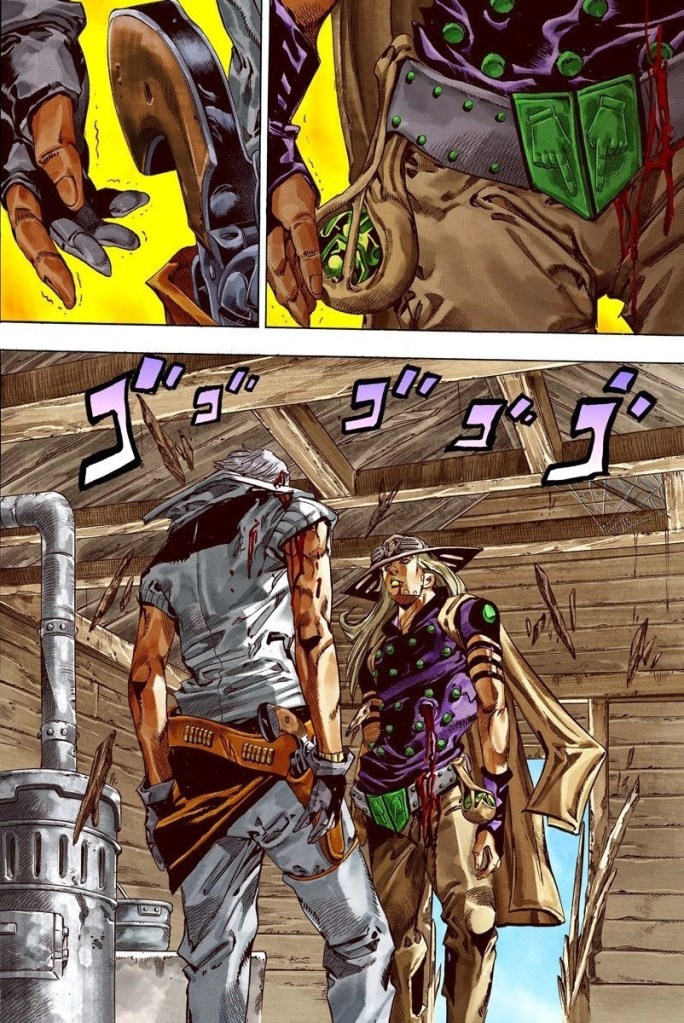Last Saturday was JoJoDay, a special fan celebration event where the official JoJo’s Bizarre Adventure anime brought back beloved voice actors and the musicians behind its banger opening themes. The event also announced an upcoming art exhibit and a Japan-only mobile game—something Western fans may not play but will certainly appreciate for its crisp new character renders. The star of the attraction was the long-awaited official announcement of David Production’s anime adaptation Steel Ball Run, the seventh part in the still-ongoing manga series. Without hesitation, I’d argue it stands as the best part of the entire series.
In contrast to previous parts, which followed generations of JoJos from 1888 to 2011, Steel Ball Run rewinds the clock back to 1890s America to follow Joestar protagonist Johnny—a paraplegic ex-jockey who enters a grueling cross-country horse race from San Diego to New York, in the hopes of winning a $50 million prize. But for Johnny, the real draw isn’t the money—it’s the chance to learn more about the enigmatic Gyro Zeppeli, a former fellow competitor whose mysterious steel balls briefly restored Johnny’s ability to walk. What unfolds is essentially a 19th-century take on Death Race 2000, where Johnny and Gyro square off against a fleet of dangerous riders with weird powers of their own.
Much of JJBA’s mass appeal is pretty simple. It features a revolving door of eccentric supermodel-looking weirdos whose names and ghost powers are peppered with music references as they battle to save the world. Along the way, the show weaves in other oddities, like a vampire’s generation-spanning vendetta against a family whose genetics he’s hijacked, the grim realities of the Floridian female prison system, and Italian gangsters waging a war on drugs. While JJBA delivers plenty of unforgettable characters and strategic, chess-like battles—like Jolyne Cujoh navigating a prison riot with literal meteorite hazards—it’s hard to ignore the sheer number of wild, last-minute asspulls the series commits.
Let’s be honest—while Araki has a habit of loosely sprinkling in hints just enough to justify how heroes and villains outmaneuver each other, a lot of the show’s better moments are because it re-adjusts how previously poorly defined powers worked at the tail end of the series (looking at you, Golden Wind). While Steel Ball Run’s release is still on the horizon, I wanted to take a moment and explore one particular battle between its heroes and a man named Ringo Roadagain, which solidified it as the crown jewel of Hirohiko Araki’s manga series.
Spoilers for that, I guess.
JJBA fights run on a tried and true formula of its heroes mysteriously encountering a villain and having to suss out how their powers work in order to exploit a weakness within it. That happened in part three with Dio’s time rewinding The World power, Diavalo’s King Crimson (whose powers are still a subject of debate to this day) in part five, and in part six with Enrico Pucci’s Infinity Stones-esque Made in Heaven. In Steel Ball Run, when Gyro and Johnny cross paths with Ringo Roadagain — a gunslinger enlisted by the president to take them from the race (don’t ask) — Ringo wastes no time explaining his ability outright. His stand, Mandom, grants him the power to rewind time back six seconds. Why reveal such a crucial detail? Well, Ringo is chasing what he calls “the True Man’s World”— a philosophy where true strength comes from one’s willingness to risk life and limb to achieve their goals. In essence, he’s on some Kraven the Hunter type shit, believing that fairness in battle is essential to proving oneself. The concept is very old hat, but it fits seamlessly into the rugged, macho cowboy setting of Steel Ball Run. To add even more machismo into their battle, Ringo and Gyro settle their affairs through an old-fashioned duel inside the quiet confines of a log cabin.

Gyro and Ringo’s duel is less a battle of strategy and more a clash of ideals. Ringo sees Gyro, who was raised Catholic and was formerly a Neapolitan executioner, as a “conformist” bound by societal and religious frameworks imposed on him. His critique of Gyro isn’t rooted in anti-Christian sentiment; rather, Ringo recognizes Gyro’s relentless drive, referred to in the series as “Dark Determination,” as something hindered by the constraints of dogmatic beliefs. Ringo’s battle with Gyro is the closest thing the series has come to a villain outright telling its hero, “We’re gonna get you some self respect, even if it kills you.” Ringo also stands out as arguably the most honorable villain in the entire series. He bows before and after duels and refrains from using his Stand against opponents without spiritual abilities, ensuring fairness in combat, which is a neat change of pace for the series.
When Gyro believes he’s cracked Ringo’s tell — the act of turning the hand on his wristwatch as a trigger to rewind time, which Gyro assumes is the physical manifestation of his stand — it’s revealed that the watch isn’t necessary at all. Ringo uses it purely to give his opponent a fighting chance. That shit is raw as hell. Although Ringo is a minor villain in the grand scheme of Steel Ball Run meant to serve as a narrative stepping stone for Gyro and Johnny to overcome as they press onward to greater challenges, this battle leaves a lasting mark on Gyro’s character. Before their journey continues, Ringo offers Gyro one final farewell.
"Welcome...to the True Man's World.”
Correction, 4/16/25, 10:45am--The original version of this article misstated the name of character Ringo Roadagain. We regret the error.


